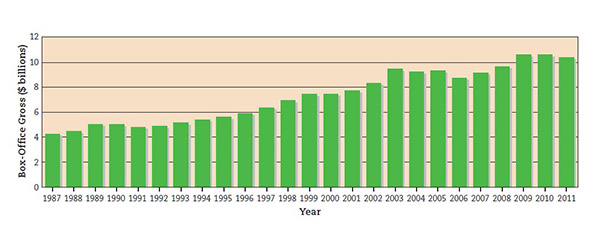Chapter 7 Visual Activities 2
Chapter 7 Visual Activities 2
CHAPTER 7: MOVIES AND THE IMPACT OF IMAGES
Focus Questions
What does this chart tell you about the movie industry over the last twenty-five years?
What changes in the movie industry have led to these changes in box-office revenues?
Gross Revenues from Box-Office Sales, 1987-2011

1 of 2
Short-Answer Questions
Question
1. How have movie theaters attempted to draw audiences back in from home entertainment?
For the most part, movie theaters are now megaplexes, with numerous screens and upscale concession areas. Giant screens and complex sound systems are designed to provide an experience that cannot be had at home. Larger, more comfortable theaters that are often equipped with stadium seating make going to the movies a special event. Theaters have also added digital projectors and IMAX screens so they can exhibit 3-D films, which command higher ticket prices and now represent a quarter of all studio releases.
2 of 2
Question
2. Where are the majority of megaplexes located, and why?
Beginning in the late 1940s, middle-class Americans moved in large numbers to the suburbs, prompting the decline of many urban movie theaters. Most large theaters are now located either in suburban shopping malls or at the crossing of major roads or highways. These theaters provide people in the suburbs easy access to the movies at a more central location.
[Leave] [Close]